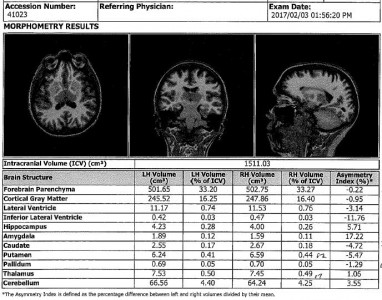Sample mould report
While mould is increasingly being seen a health hazard it is only one of many contaminates likely to cause negative health impact in water damaged properties.
Wet building materials can release various chemical volatile organic compounds (VOCs) including formaldehyde and a synergy between a host of potential contaminates can produce a very toxic atmosphere.
While active mould growth is a concern the real hazard is the spores it releases during its life cycle or during cleaning or removal.
It is now recognised that dead or non -viable mould and fragements are a greater helath hazard than viable or whole spores.
The following report by our sister company “Building Forensics” shows typical findings of homes affected by moisture problems and resultant mould and contamination issues.(link to report)
Health effects of mould
The photo on the left shows typical brain inflamation as identified by the new Neuroquant MRI scan. The information gathered shows peripheral brain inflamation which can be reduced by treatment and removal from the source of inflamation which is usually linked to water damage contaminates. These brain effects are best described by the term Chronic Inflamatory Response Syndrome (CIRS) and the cause and effect can be seen in the following connsensus document. (Link)
Neuroquant MRI scan. The information gathered shows peripheral brain inflamation which can be reduced by treatment and removal from the source of inflamation which is usually linked to water damage contaminates. These brain effects are best described by the term Chronic Inflamatory Response Syndrome (CIRS) and the cause and effect can be seen in the following connsensus document. (Link)
The UK has the highest level of asthma in the world and mould is now recognised by the World Health Organisation as the major trigger. This is substantiated by the prestigious medical journal Lancet. The Royal Institute of Chartered Surveyors published a paper that stated they found toxic mould in 40% of homes surveyed.(link to paper)
While live and viable mould may be pathogenic and cause various helath issues, the WHO and international; opinion recognise that dead mould and its fragments may be 40 times more hazardous. This is because human defence mechanisms have no natural defecne to the microscopic allergenic and potentially toxic fragments. These fragments can be adsorbed into the lower respiratory system and enter the blood stream.
Medical opinion. You can find as many papers on toxic mould as you can that it doesnt exist. Most doctors are not trained in toxicology and invariably undertake skin allergy testing and state you are not affected by mould. The WHO actually state you will get more helath information on toxic mould from a vet who is trained in recognising health impact from mould. The author of this site Jeff Charlton has absolutley no medical training and provides annecdotal evidence and reference papers only.
Toxic Mould may trigger or exasperate medical conditions or symptoms such as :
• Burning skin & unexplained rashes
• Insect skin crawling sensation
• Skin blotches
• Eye infection, vision issues, flashing lights
• Flu like symptoms and ache joints
• Swollen tingling lips, throat and eye lids
• Upper respiratory issues
• Memory issues and brain fog
• Ice pick headaches
• Gynecological problems (early menopause)
• Stomach upset
• Static electric shocks
• Metal taste
Brain damage
Toxic mould can sause adverse symptoms to the endocrine system and cause neurogilcal symptoms.These issues should be discussed with medical professionals but we have seen emeging research which proves brain inflamation and more importantly a reduction in the inflamation following treatment and either decontamination or re location. (see decontamination section)
Some types of blood tests can identify the presence of mould in the blood and sputum. Long term mould exposure can be expected to have health ramifications on all exposed and this may be severe in those with compromised immune systems such as the young, old and those on long term prescription drugs or undergoing chemo or radio therapy. We can undertake specific tests to identify various likley contaminates from mycotoxins to chemical and gas phase pollutants. This can assist your medical team and toxicologist. Be aware that most doctors in the UK have no training on mould illness and often rely on skin allergy testing. Toxic mould is not an allergy it is a toxin and you may require expert help from a toxicologist
The following web links to internationally recognised bodies provide evidence of the health risks:
Environmental Protection Agency


